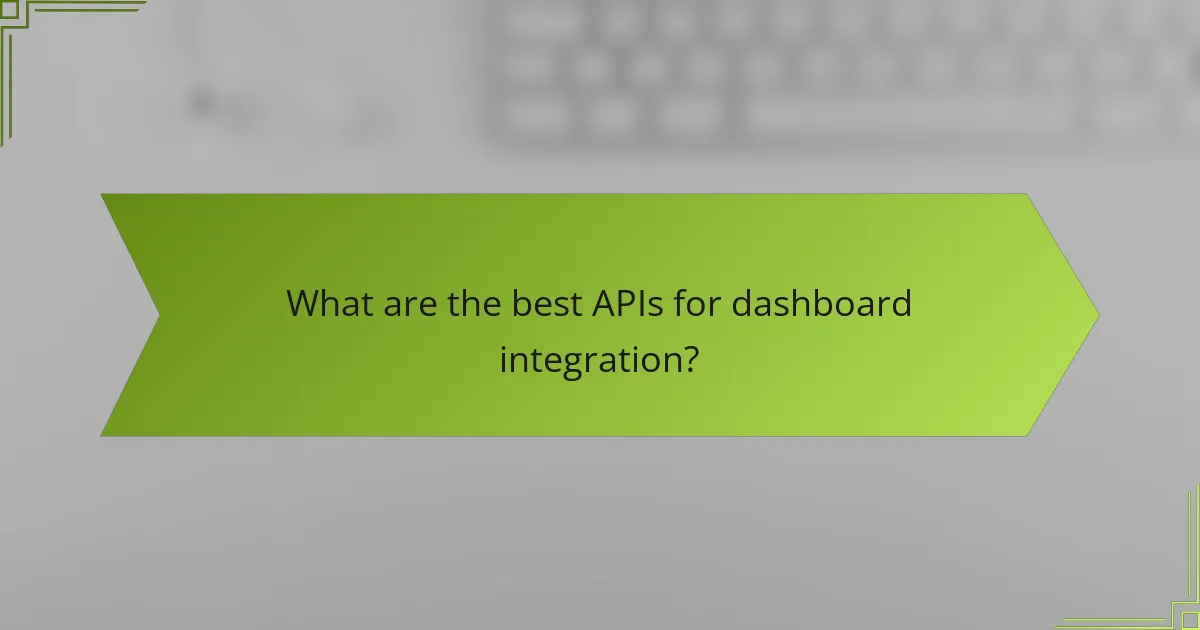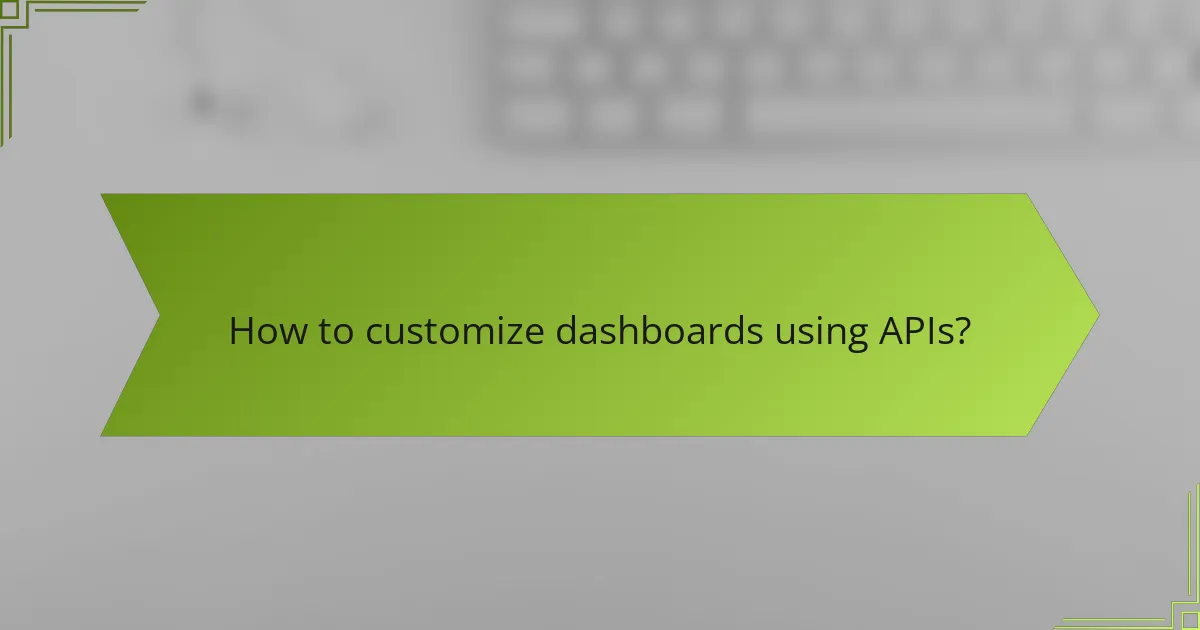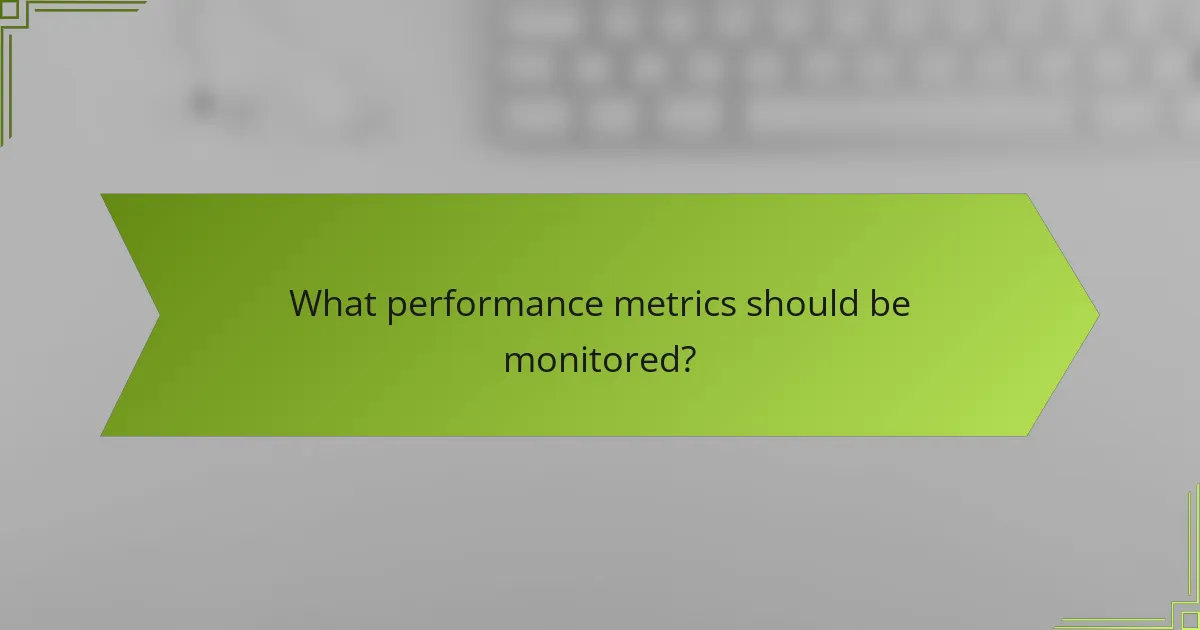APIs play a crucial role in enhancing dashboard functionality by facilitating the integration of real-time data, enabling user interface customization, and optimizing performance metrics. This leads to improved decision-making and a more engaging user experience. By leveraging APIs like Google Charts, Tableau, and Microsoft Power BI, users can create tailored dashboards that meet their specific data visualization needs.

How can APIs enhance dashboard functionality in the US?
APIs can significantly enhance dashboard functionality in the US by enabling seamless integration of real-time data, allowing for customizable user interfaces, and improving performance metrics. These enhancements lead to more informed decision-making and a better user experience.
Real-time data integration
Real-time data integration through APIs allows dashboards to display up-to-the-minute information from various sources. This capability is crucial for businesses that rely on timely data, such as financial services or e-commerce, where market conditions can change rapidly.
To implement real-time data integration, consider using webhooks or streaming APIs that push updates automatically. This reduces the need for manual refreshes and ensures users always have access to the latest information.
Customizable user interfaces
APIs facilitate the creation of customizable user interfaces, enabling users to tailor dashboards to their specific needs. This customization can include choosing which data to display, adjusting layouts, and selecting visualizations that best represent the data.
When designing customizable interfaces, prioritize user feedback to understand their preferences. Providing options for drag-and-drop functionality or theme selection can enhance user engagement and satisfaction.
Improved performance metrics
APIs can improve performance metrics by allowing dashboards to aggregate and analyze data from multiple sources efficiently. This capability helps organizations track key performance indicators (KPIs) in real-time, leading to quicker insights and better strategic decisions.
To maximize performance, ensure that your APIs are optimized for speed and reliability. Regularly monitor API response times and consider caching strategies to reduce load times, which can enhance the overall user experience on the dashboard.

What are the best APIs for dashboard integration?
The best APIs for dashboard integration include Google Charts API, Tableau API, and Microsoft Power BI API. Each of these APIs offers unique features and capabilities that cater to different data visualization needs and user preferences.
Google Charts API
Google Charts API is a powerful tool for creating interactive charts and data visualizations directly in web applications. It supports a wide range of chart types, including line, bar, and pie charts, allowing for flexibility in presentation.
To use Google Charts, developers need to include the library in their project and define the data source. The API is free to use, making it an attractive option for startups and small businesses. However, it requires a stable internet connection for loading charts.
Tableau API
Tableau API provides robust capabilities for integrating Tableau visualizations into web applications. It allows developers to embed dashboards, create custom visualizations, and interact with Tableau Server or Tableau Online.
Using the Tableau API requires familiarity with Tableau’s data structure and authentication methods. It is ideal for organizations that already utilize Tableau for data analytics, but it may involve licensing costs depending on the usage level.
Microsoft Power BI API
The Microsoft Power BI API enables developers to integrate Power BI reports and dashboards into their applications seamlessly. It supports embedding content and managing user access, making it suitable for enterprise environments.
To utilize the Power BI API, developers must have a Power BI account and understand the OAuth authentication process. While it offers extensive features, the API is best suited for businesses already invested in the Microsoft ecosystem, which may lead to additional costs.

How to customize dashboards using APIs?
Customizing dashboards using APIs involves integrating various data sources, defining metrics, and creating visual representations tailored to user needs. This process enhances the functionality and relevance of dashboards, allowing for a more personalized user experience.
Dynamic data sources
Dynamic data sources allow dashboards to pull real-time information from multiple APIs, ensuring that users have access to the latest data. When selecting data sources, consider the reliability and update frequency of the APIs to maintain accuracy.
Common examples include integrating social media feeds, financial market data, or IoT device metrics. Ensure that the APIs you choose can handle the expected data volume and provide adequate response times, typically within low tens of milliseconds for optimal performance.
User-defined metrics
User-defined metrics empower users to create custom calculations based on the data retrieved from APIs. This flexibility enables the tailoring of insights to specific business needs, such as calculating conversion rates or customer lifetime value.
To implement user-defined metrics, ensure your API supports custom queries or calculations. Provide clear documentation and examples to help users define their metrics effectively, avoiding overly complex formulas that may lead to errors.
Custom visualizations
Custom visualizations transform raw data into meaningful graphical representations, enhancing user comprehension. Choose visualization types that best represent the data, such as line charts for trends or bar graphs for comparisons.
When creating custom visualizations, consider the tools and libraries available, such as D3.js or Chart.js, which offer extensive customization options. Ensure that visualizations are responsive and accessible, catering to various devices and user preferences.

What performance metrics should be monitored?
Monitoring performance metrics is crucial for ensuring that APIs in dashboard functionality operate efficiently. Key metrics include load times, data refresh rates, and user engagement statistics, which help identify areas for improvement and optimize user experience.
Load times
Load times refer to the duration it takes for a dashboard to fully display its content after a user initiates a request. Ideally, load times should be kept under two seconds to maintain user satisfaction. Longer load times can lead to frustration and increased bounce rates.
To optimize load times, consider implementing techniques such as lazy loading, caching frequently accessed data, and minimizing the size of API responses. Regularly test load times across different devices and network conditions to ensure consistent performance.
Data refresh rates
Data refresh rates indicate how often the information displayed on a dashboard is updated. Depending on the application’s requirements, refresh rates can range from real-time updates to hourly or daily intervals. Striking a balance between timely data and system performance is essential.
For instance, financial dashboards may require real-time data, while analytics dashboards might suffice with hourly updates. Monitor the impact of refresh rates on server load and user experience to find the optimal frequency for your specific use case.
User engagement statistics
User engagement statistics measure how actively users interact with the dashboard, including metrics like session duration, frequency of use, and feature adoption rates. High engagement typically indicates that users find the dashboard valuable and easy to use.
To enhance user engagement, analyze patterns in user behavior and identify features that are underutilized. Implement feedback mechanisms to gather user insights and make iterative improvements based on their needs and preferences.

What are the prerequisites for API integration?
Successful API integration requires a solid understanding of technical expertise and robust data security measures. These prerequisites ensure that the integration process is efficient, secure, and tailored to the specific needs of the dashboard functionality.
Technical expertise
Technical expertise is essential for effective API integration. This includes familiarity with programming languages such as JavaScript, Python, or Ruby, as well as knowledge of RESTful services and JSON data formats. Understanding how to work with APIs and their documentation is crucial for troubleshooting and optimizing performance.
It’s advisable to have team members who are experienced in software development and system architecture. This expertise helps in designing a seamless integration that can handle various data sources and ensure compatibility with existing systems.
Data security measures
Implementing strong data security measures is critical when integrating APIs. This involves using secure protocols like HTTPS to encrypt data in transit and ensuring that sensitive information is protected through proper authentication methods, such as OAuth or API keys. Regularly updating these security protocols is also necessary to mitigate potential vulnerabilities.
Additionally, organizations should conduct thorough security assessments and audits of the API integration process. This helps identify any weaknesses and ensures compliance with relevant regulations, such as GDPR or CCPA, which govern data protection and privacy.

What are the challenges of API integration in dashboards?
API integration in dashboards presents several challenges, including data consistency, performance issues, and security concerns. These obstacles can impact the overall user experience and the effectiveness of data visualization.
Data Consistency
Ensuring data consistency is crucial when integrating APIs into dashboards. Discrepancies can arise from different data sources, leading to inaccurate visualizations. It’s important to implement data validation checks and establish a single source of truth to mitigate these issues.
Consider using data transformation tools to harmonize data formats and structures. This can help maintain consistency across various APIs and improve the reliability of the dashboard.
Performance Issues
Performance can be significantly affected by API integration, particularly if multiple APIs are called simultaneously. Latency issues may arise, leading to slow dashboard load times. To enhance performance, prioritize API calls and consider caching frequently accessed data.
Utilizing asynchronous calls can also improve responsiveness. This allows the dashboard to load essential data first while fetching additional information in the background.
Security Concerns
Security is a major concern when integrating APIs, especially if sensitive data is involved. It’s essential to implement proper authentication and authorization mechanisms to protect data integrity. Using HTTPS for API calls can also help secure data in transit.
Regularly review API permissions and limit access to only necessary data. This minimizes the risk of data breaches and ensures compliance with regulations like GDPR or CCPA, depending on your locale.
